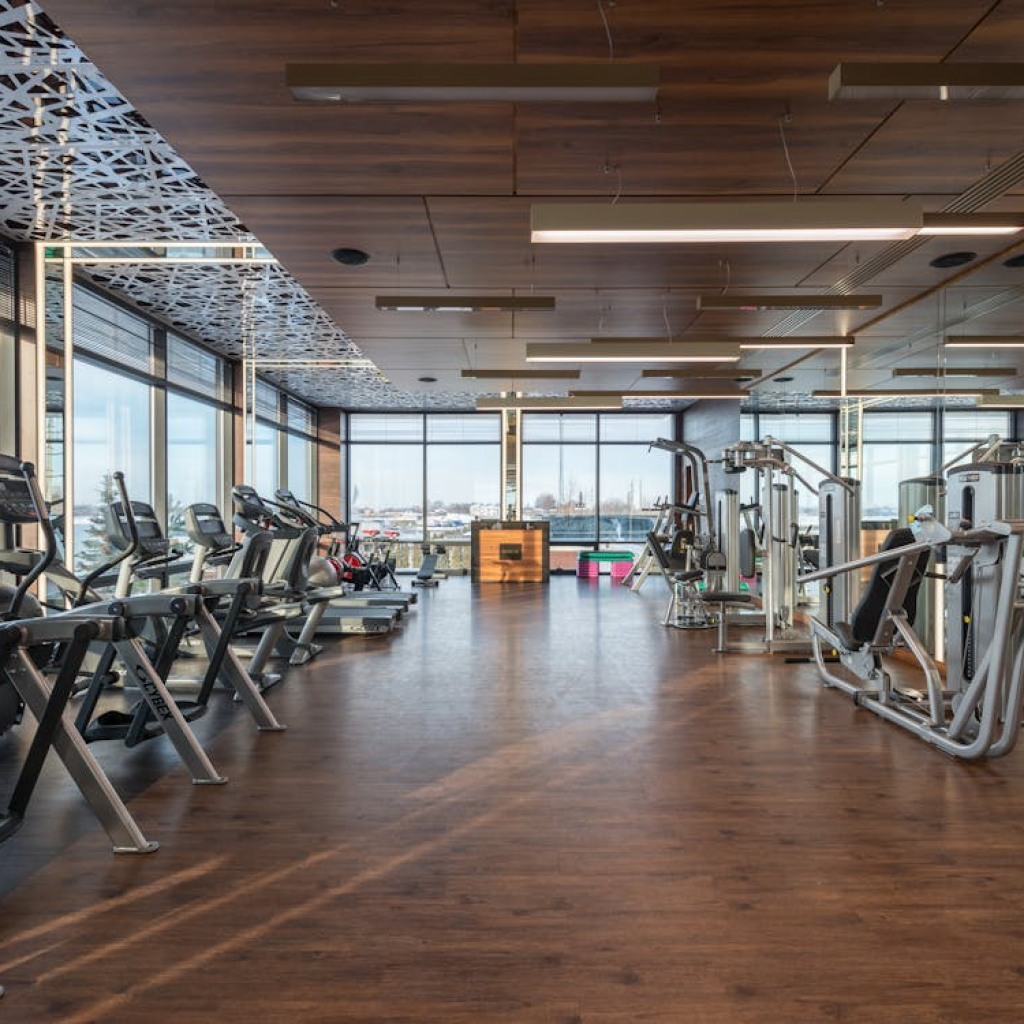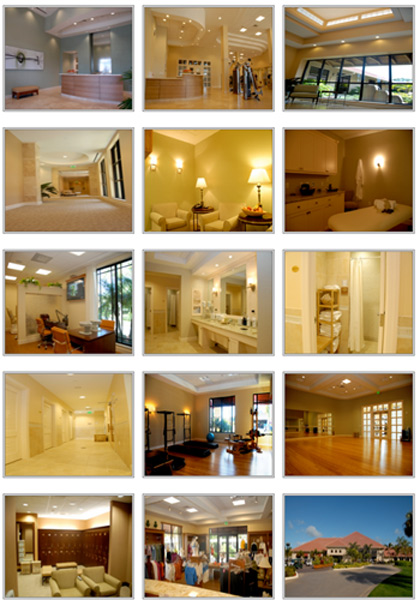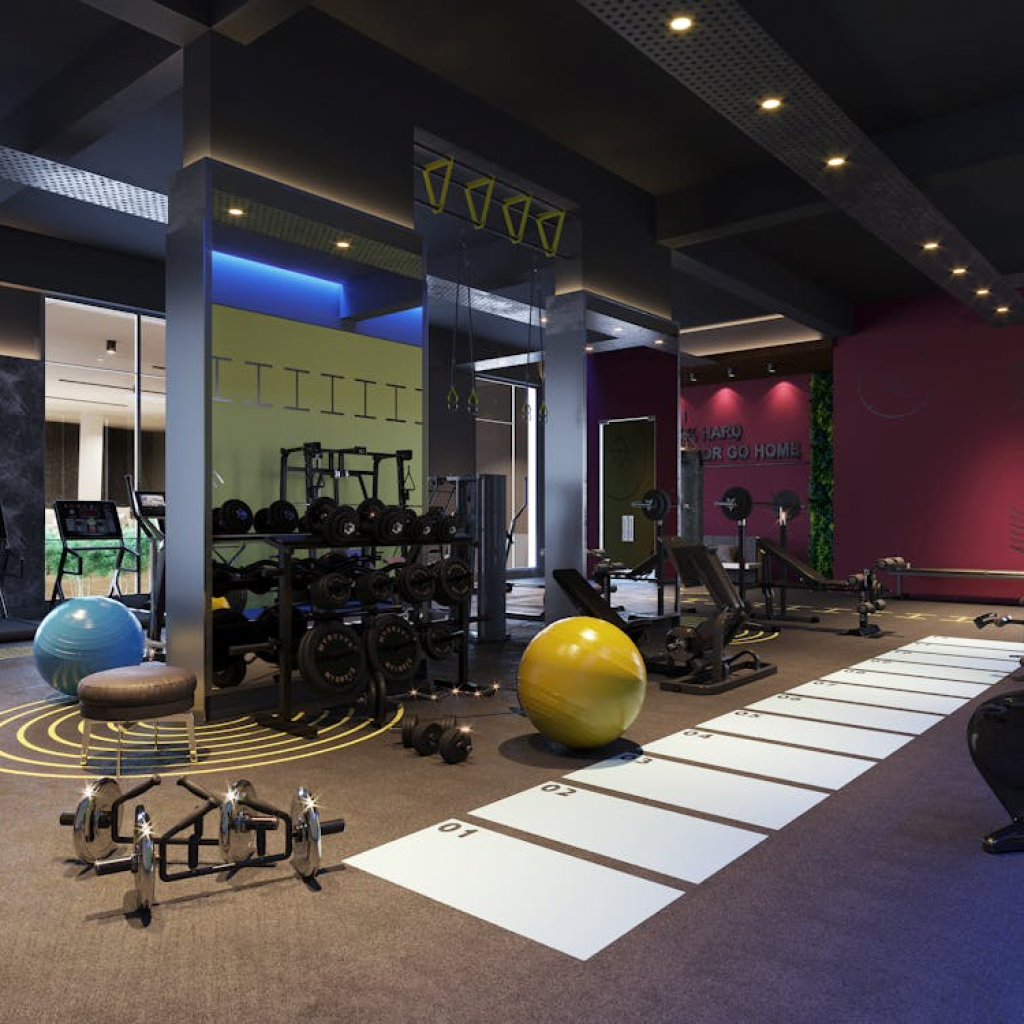Gym Design Essentials, Strategies, and Tips
Key Points
- Prioritizing sustainability, thoughtful aesthetics, and member-focused amenities creates a welcoming atmosphere that boosts retention and supports long-term success.
- Planning for a gym or fitness studio includes strategic gym design elements like zoning, equipment selection, and technology integration to enhance member experience and operational efficiency.
- Adaptable layouts, modular features, and scalable technology ensure your fitness club remains competitive and ready to accommodate future trends and member needs.
Table of Contents
- Health Club or Gym Design & Build-Out
- Enhancing Member Experience Through Gym Design
- Gym Design for Adaptability and Future Growth
- Turning Vision into Reality
- Designing a Gym or Fitness Club for Maximum Impact
- Setting Fitness Goals: The Foundation of Great Gym Design
- Maintaining Your Gym: Keeping Your Investment in Top Shape
- Troubleshooting Common Gym Design Issues
- Summary
- Need Help Creating the Perfect Design?
Health Club or Gym Design & Build-Out
Our gym design consultants bring extensive expertise in managing projects for a wide range of facilities, including health clubs, gyms, leisure areas, and recovery rooms. With a proven track record in the development of innovative fitness and wellness facilities, our consultants have successfully completed projects for both individual and corporate clients.
We offer comprehensive design services tailored to the unique needs of each client, covering every aspect from concept development and gym interior design, including developing a comprehensive gym concept that aligns with the client’s brand image and target audience, to equipment placement and strategic planning.
Our experience spans residential, commercial, and high-profile assignments, ensuring that every project benefits from our specialized knowledge and commitment to excellence in wellness space design.
We collaborate closely with professional interior designers to create personalized, aesthetically pleasing, and functional gym design ideas. Our influence extends throughout the world of fitness and wellness design, with a global reach and impact in the industry.
Enhancing Member Experience Through Gym Design
Your fitness club’s design directly impacts member retention. Every detail, from lighting to acoustics, plays a role in creating a welcoming environment that inspires motivation and loyalty. Effective management of design elements—through project management and wellness space management—ensures that all aspects are coordinated to enhance the overall member experience.
- Ambient Lighting: Adjust lighting based on workout zones. Bright, energetic lighting works well in cardio areas, while dimmer lights create a relaxing mood in yoga studios or recovery zones.
- Acoustic Planning: High-quality sound insulation is critical for separating noisy workout areas from quieter zones like yoga or wellness spaces. A well-planned acoustic design ensures all members can enjoy their activities without distraction.
- Appealing Aesthetics: The color scheme, decor, and branding cues should align with your club’s identity. For example, energizing tones like orange and yellow work well in active cardio zones, while softer shades like blue and green pair perfectly with relaxation areas.
Gym Design for Adaptability and Future Growth
Fitness trends evolve rapidly, and your club should be able to adapt to these changes without a full remodel. Plan for scalability and flexibility to remain competitive in the long term.
- Modular Design Features: Modular walls or movable equipment allow you to reconfigure spaces as needs change. For example, if demand for HIIT classes surges, you can quickly adjust your layout to accommodate larger groups.
- Space for Future Trends: Dedicate certain areas for potential future needs, like recovery lounges or VR-based workout experiences. Staying proactive ensures your club remains relevant and competitive.
- Scalable Technology: Adopt tech solutions that can grow with your club. Cloud-based systems or customizable apps can evolve as you add services or expand locations.
Turning Vision into Reality
Designing a fitness club is about more than just aesthetics. It’s about creating a space that aligns with operational goals, member satisfaction, and market demands. A structured process guides the project from concept to completion, covering each step from equipment selection to flooring and décor choices. Whether you’re optimizing traffic flow, integrating technology, or adopting sustainable practices, the right design decisions can significantly boost your club’s success.
A well-designed fitness club not only attracts new members but also encourages long-term loyalty. Collaboration among the design team and other professionals, such as MEP and operations teams, is essential to achieve project goals. By focusing on thoughtful planning, strategic investments, and adaptable layouts, fitness clubs can thrive in today’s competitive market while delivering an unparalleled experience for every member.

Designing a Gym or Fitness Club for Maximum Impact
Creating a fitness club that stands out in today’s competitive market starts with exceptional design that meets commercial standards and leverages professional interior design expertise. From the layout and equipment selection to technology integration and sustainability, every element plays a critical role in delivering value to both members and stakeholders. Thoughtful gym design can also be a cost-effective investment, maximizing return while minimizing unnecessary expenditure. Wellness interior design is essential for creating healthy, inspiring environments that promote wellbeing for all members. Here’s how to craft a fitness space that drives success.
1. Nail the Layout
The layout is the backbone of your fitness club’s design. A seamless flow ensures that members not only find it easy to navigate but also feel motivated to stay longer.
- Zoning: Allocate distinct areas for cardio machines, strength training, functional fitness, and group classes. Consider creating dedicated rooms for specific activities, such as a meditation room or wellness room, to enhance versatility and cater to different member needs. Clear separation minimizes congestion and maximizes usage, while aligning your equipment line with the overall layout ensures optimal flow.
- Pathways: Ensure aisles are wide and equipment is strategically placed to avoid bottlenecks, keeping the equipment line consistent with the club’s layout for smooth movement.
- Visible Amenities: Position key features like restrooms, water stations, and locker rooms near high-traffic areas for easy access.
Well-thought-out layouts improve member satisfaction and encourage repeat visits.
2. Select Equipment Wisely
Your equipment lineup should cater to diverse fitness needs while reflecting the latest industry trends.
- Balance Variety and Functionality: Include a mix of traditional machines, free weights, and modern functional fitness tools, ensuring you select a range of exercise equipment to meet the needs of all members.
- Focused Equipment Selection: Take a focused approach to equipment selection, aligning choices with your club’s specific goals and member preferences.
- Ease of Use: Opt for user-friendly machines with clear instructions.
- Tech-Enhanced Options: Invest in equipment with screens or digital connectivity for virtual workouts and progress tracking.
Quality, durable equipment also reduces maintenance costs and downtime. Make informed purchase decisions to ensure you get the best value and quality for your gym.
3. Integrate Cutting-Edge Technology
A tech-forward fitness club isn’t just a luxury; it’s a necessity to stay competitive.
- Smart Access Systems: Simplify member check-ins with keyless entry and mobile app integration.
- Digital Connectivity: Offer integrated apps for members to track their activities and goals.
- Entertainment Features: Embedded screens and personalized content on cardio equipment enhance the workout experience and can help increase gym memberships through better member engagement.
Investing in technology boosts operational efficiency while improving overall user satisfaction.
4. Prioritize Sustainability
Designing with sustainability in mind not only caters to eco-conscious members but also cuts operational costs.
- Energy Efficiency: Use LED lighting, energy-efficient HVAC systems, and motion-sensor technology.
- Sustainable Materials: Incorporate recycled flooring and low-VOC paint for a greener footprint.
- Recycling Programs: Offer visible and easy-to-use recycling stations throughout the club.
A sustainable approach not only appeals to modern consumers but also demonstrates your commitment to environmental responsibility.
5. Create a Welcoming Atmosphere
How your club feels when someone walks in can make or break the impression. Thoughtful design can also serve as inspiration for members to achieve their fitness goals.
- Color Palette: Use motivating colors like blues to promote calm, or reds for energy.
- Lighting: Combine natural light with ambient lighting to create a welcoming vibe. Features like rubber flooring not only enhance safety but also contribute to the overall atmosphere and aesthetic of a high-end fitness space.
- Sound Design: Incorporate custom soundtracks or separate sound zones to fit the atmosphere of each workout area.
Small details make a big difference in member retention and experience.

6. Elevate with Luxury Wellness Interiors
Transforming your gym into a luxury wellness retreat can redefine your fitness experience. Our expertise in custom gym designs ensures each space blends high-end aesthetics with personalized functionality, creating a bespoke environment tailored to your needs. A luxury gym design goes beyond basic functionality, focusing on creating a serene, inspiring space that supports both physical and mental well-being.
- Premium Materials: Incorporate high-end materials such as natural wood accents, elegant stone flooring, and plush carpets to add warmth and sophistication to your gym.
- Designer Touches: Work with an experienced interior designer to select bespoke accessories and finishes that reflect your personal style and elevate the overall ambiance.
- Integrated Wellness Features: Blend form and function by including features like ambient lighting, custom mirrors, and artful storage solutions for fitness equipment and accessories.
- Seamless Flow: Ensure your luxury gym layout allows for smooth transitions between workout zones, relaxation areas, and wellness spaces.
By creating a luxury wellness interior tailored to your unique needs, you can enjoy a gym that is as beautiful as it is functional—making every workout a rejuvenating experience.
7. Integrate Biohacking and Recovery Zones
Take your gym design to the next level by integrating dedicated biohacking and recovery zones. These specialized spaces are designed to optimize your fitness results and support holistic wellness.
- Biohacking Technology: Incorporate advanced equipment such as cryotherapy chambers, infrared saunas, and red light therapy devices to enhance recovery and performance.
- Recovery Rooms: Designate quiet rooms for meditation, stretching, or mindfulness practices, helping you recharge both body and mind.
- Personalized Equipment Selection: Choose technology and tools that align with your specific fitness goals, ensuring each element of your gym supports your journey.
- Holistic Wellness Focus: Create a balanced environment where high-intensity workouts and restorative practices coexist, maximizing the benefits of your fitness space.
By thoughtfully designing biohacking and recovery zones, you can create a gym that not only helps you achieve your fitness goals but also supports long-term wellness and vitality.
8. Apply High-Performance Gym Design Principles
A high-performance gym is built on principles that prioritize efficiency, motivation, and results. Applying these design strategies ensures your fitness facility or gym is both inspiring and practical.
- Expert Equipment Selection: Choose top-tier fitness equipment that supports a wide range of workouts, from strength training areas to cardio and functional training spaces.
- Optimized Layout: Design your gym layout to facilitate smooth movement between zones, reducing clutter and enhancing the workout experience.
- Smart Storage Solutions: Integrate innovative storage options to keep equipment organized and accessible, maintaining a clean and inviting space.
- Superior Materials and Lighting: Use durable flooring, high-quality materials, and strategic lighting to create a safe, motivating environment.
- Technology Integration: Leverage the latest fitness technology to track progress, personalize workouts, and keep members engaged.
For more advice on building a successful fitness business, explore these 9 marketing keys for newly opened or soon to launch health clubs and fitness studios.
By focusing on these high-performance gym design principles, you can create a space that meets your unique needs, supports diverse fitness goals, and delivers exceptional results.
9. Plan, Order, and Install Gym Equipment
A successful gym starts with careful planning, smart equipment selection, and professional installation. Each step is crucial to creating a functional and inspiring workout environment.
- Custom Gym Layout: Collaborate with an interior designer or fitness consultant to develop a layout that maximizes your available space and aligns with your fitness goals.
- Selecting Equipment: Choose gym equipment that fits your workout preferences, space constraints, and budget, ensuring a balanced mix of cardio, strength, and flexibility tools.
- Efficient Delivery and Installation: Schedule timely delivery and expert installation to minimize downtime and ensure your equipment is set up safely and correctly.
- Quality and Durability: Invest in reputable brands and high-quality materials to guarantee long-lasting performance and minimal maintenance.
By planning every detail—from layout to installation—you can create a gym that is both functional and motivating, empowering you to achieve your wellness objectives with ease.

Setting Fitness Goals: The Foundation of Great Gym Design
Setting clear fitness goals is the cornerstone of any successful gym design, whether you’re outfitting a fitness center, or developing a luxury gym. Defining your fitness objectives at the outset helps guide every decision—from equipment selection to custom gym layout—ensuring your space is both functional and inspiring.
When you identify your fitness goals, you can tailor your gym design to support the types of workouts you want to prioritize, such as strength training, cardio, or group exercise. For example, a custom gym layout focused on strength training might include dedicated strength training areas and specialized exercise equipment, while a compact gym for cardio would emphasize space-saving machines and open floor space for movement.
Working with an interior designer or fitness consultant provides expert guidance throughout the process, helping you select the right equipment and design a gym layout that fits your unique needs, available space, and budget. This collaborative approach ensures your gym or fitness facility is optimized for your specific workouts and wellness objectives.
Regularly reviewing and updating your fitness goals is also essential. As your needs evolve, you can adjust your gym design and equipment selection to keep your space effective, motivating, and aligned with your health and wellness journey. By making fitness goals the foundation of your gym design process, you create a space that not only looks great but also supports your long-term success and well-being.
Maintaining Your Gym: Keeping Your Investment in Top Shape
A well-designed gym is a significant investment in your health and wellness—so keeping it in top shape is essential. Regular maintenance ensures that your gym, fitness center, or luxury wellness facility remains safe, functional, and inviting for every workout.
Developing a maintenance schedule is key to protecting your investment. Routine tasks like cleaning, inspecting exercise equipment, and performing minor repairs help prevent injuries and reduce the risk of costly breakdowns. For gym owners and facility managers, working with a professional maintenance team or trusted equipment supplier can provide expert guidance on best practices, extending the life of your equipment and facilities.
Regularly inspecting and replacing worn or damaged equipment is crucial for maintaining a safe workout environment. A clean, organized gym not only enhances the user experience but also supports your fitness goals by creating a welcoming space that motivates you to stay active.
Prioritizing maintenance also helps control costs by reducing the need for major repairs or replacements. By keeping your gym in excellent condition, you ensure it remains a valuable resource for clients, family members, or yourself—supporting health, wellness, and an active lifestyle for years to come.
Troubleshooting Common Gym Design Issues
Even the best-designed gyms can face challenges that impact functionality and user satisfaction. Common gym design issues—such as inadequate lighting, insufficient storage, or poor equipment layout—can detract from the overall experience and hinder progress toward fitness goals.
Addressing these issues starts with a careful assessment of your space and a willingness to adapt. Working with an interior designer or fitness consultant can provide expert guidance on identifying and resolving design challenges. Solutions might include upgrading lighting to create a brighter, more energizing environment, reconfiguring the gym layout to improve traffic flow, or adding smart storage solutions to keep equipment organized and accessible.
Selecting the right equipment for your available space is also critical. Overcrowding can lead to safety hazards and a less enjoyable workout experience, while a well-planned layout ensures every square foot is used effectively. Considering the unique needs of your users—such as accessibility requirements or specialized equipment—helps create a gym that is inclusive and functional for everyone.
Regularly reviewing your gym’s design and making adjustments as needed can help you stay ahead of potential issues, ensuring your facility remains a safe, inspiring, and effective space for achieving fitness and wellness goals. By prioritizing user experience and seeking expert guidance, you can turn challenges into opportunities for growth and development, keeping your gym at the forefront of health and wellness innovation.
Summary
Embarking on a design project to transform your fitness club is more than just about aesthetics; it’s the key to member satisfaction, operational success, and profitability.
By focusing on strategic layouts, high-quality equipment, integrated technology, sustainability, and a welcoming atmosphere, you’ll create a space that stands out—and discover the value of a complete design solution for achieving operational success.
For further reading, you can check out our comprehensive guide on How to Open a Gym or Studio to gain context on where your gym design fits into building a successful fitness business. You can also explore ACSM’s authoritative Health/Fitness Facility Standards and Guidelines for elevating care in fitness spaces.


